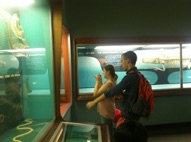Courses
PMB C109/IB C109
Evolution and Ecology of Development (UCB)
From the seahorse’s body to the venus flytrap’s jaws to the human brain, nature abounds with amazing adaptations. This interdisciplinary course explores how and why such biodiversity evolves as well as what limits diversity. Lectures and case studies will focus on core concepts, recent advances, and integrative approaches, placing special emphasis on the interplay between gene regulatory networks, the environment, and population genetics.
BIOL 8084 Speciation (UVA)
Where do new species come from? Though Darwin once considered this question to be "that mystery of mysteries", our scientific understanding of this process has been transformed dramatically by modern approaches. Through critical reading of classic and contemporary studies, this course considers these major developments. Topics including species concepts, speciation genetics, ecological speciation, and reinforcement are covered.


EvoEcoDevo student teams gathering observations and developing hypotheses at the National Museum of Natural History for a class project. Check out their final wikis here!
PMB 200C
Plant Diversity and Evolution (UCB)
The natural world is replete with genetic and phenotypic diversity. We observe this diversity within species, between species, and at higher taxonomic levels. In this course, we will take a process-based approach toward understanding how this diversity arises and is maintained,
especially as relevant to plant evolution and breeding. Topics include population genomics, QTL and association mapping, domestication, mating system evolution, local adaptation, and speciation.
Biology 1B
General Biology (UCB)
In the organismal biology section of this introductory biology course, students learn to identify major groups in the plant and microbial world, and describe the key evolutionary innovations that distinguish their anatomies and life cycles and that have promoted their diversification. The section also introduces students to the myriad connections between the biology of microbes, fungi, and plant life and the critical roles they play in the environment, in the economy, and in human health and culture. Students also learn mechanisms by which plants cope with and engineer the environments they experience by sensing and responding to changing physical and biotic conditions